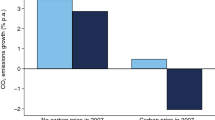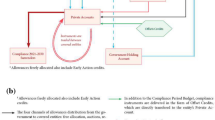Abstract
In this paper, based on the framework of the single-period model, we establish an optimal control model for the inheriting period which allows inter-phase banking and borrowing of allowances under the cap-and-trade system. By considering the abatement control policy and the initial auction amount of allowances, we optimize the problem in two steps. The two models can then be expressed using the Hamilton–Jacobi–Bellman (HJB) equations. In the framework of viscosity solution, we prove that the value functions in two models are the unique viscosity solutions of the corresponding HJB equations. Finally, we analyze the properties of optimal policy by referring to numerical results and a comparison of the two models is presented. Our results show that under the same circumstances, allowing inter-phase banking and borrowing of allowances indeed reduces the company’s abatement costs and has an incentive-based effect on the company’s emission reductions.








Similar content being viewed by others
References
Hepburn, C.: Carbon trading: a review of the kyoto mechanisms. Annu. Rev. Environ. Resour. 32, 375–393 (2007)
Carmona, R., Fehr, M., Hinz, J.: Optimal stochastic control and carbon price formation. SIAM J. Control Optim. 48, 2168–2190 (2009)
Carmona, R., Fehr, M., Hinz, J., Porchet, A.: Market design for emission trading schemes. SIAM Rev. 52, 403–452 (2010)
Zagheni, E., Billari, F.C.: A cost valuation model based on a stochastic representation of the IPAT equation. Popul. Environ. 29, 68–82 (2007)
Wang, M., Wang, M., Wang, S.: Optimal investment and uncertainty on China’s carbon emission abatement. Energy Policy 41, 871–877 (2012)
Yang, X., Liang, J.: Minimization of the nation cost due to carbon emission. Syst. Eng. Theory Pract. 34, 640–647 (2014)
Yang, X., Liang, J., Hu, B.: Minimization of carbon abatement cost: Modeling, analysis and simulation. Discrete Contin. Dyn. Syst. Ser. B 22, 2939–2969 (2017)
Guo, H., Liang, J.: An optimal control model for reducing and trading of carbon emissions. Phys. A 446, 11–21 (2016)
Guo, H., Liang, J.: An optimal control model of carbon reduction and trading. Math. Control Relat. Fields 6, 535–550 (2016)
Guo, H.: Research on stochastic optimization model related to carbon emission reduction and carbon trade. Tongji University, Shanghai (2018). Doctoral thesis
Ye, B.: EU-ETS 3-phase quota distribution and its evolution. China Open. J. 3, 64–68 (2013)
Schleich, J., Ehrhart, K.M., Hoppe, C., Seifert, S.: Banning banking in EU emissions trading? Energy Policy 34, 112–120 (2006)
Chevallier, J.: Banking and borrowing in the EU ETS: a review of economic modelling, current provisions and prospects for future design. J. Econom. Surv. 26, 157–176 (2012)
Rubin, J.D.: A model of intertemporal emission trading, banking, and borrowing. J. Environ. Econ. Manage. 31, 269–286 (1996)
Liang, J., Huang, W.: Optimal control strategy of companies: inheriting period and carbon emission reduction. Math. Probl. Eng. (2020). https://doi.org/10.1155/2020/3461747
Crandall, M.G., Lions, P.L.: Viscosity solutions of Hamilton–Jacobi equations. Trans. Am. Math. Soc. 277, 1–42 (1983)
Crandall, M.G., Lions, P.L.: User’s guide to viscosity solutions of second order partial differential equations. Bull. Am. Math. Soc. (N.S.) 27, 1–67 (1992)
Seifert, J., Uhrig-Homburg, M., Wagner, M.: Dynamic behavior of \(CO_2\) spot prices. J. Environ. Econ. Manage. 56, 180–194 (2008)
Pham, H.: Continuous-time stochastic control and optimization with financial applications. Springer-Verlag, Berlin Heidelberg (2009)
Daggash, H.A., Heuberger, C.F., Dowell, N.M.: The role and value of negative emissions technologies in decarbonising the UK energy system. Int. J. Greenh. Gas Control 81, 181–198 (2019)
Bui, M., Fajardy, M., Dowell, N.M.: Bio-energy with carbon capture and storage (BECCS): Opportunities for performance improvement. Fuel 213, 164–175 (2018)
Creutzig, F., Ravindranath, N.H., Berndes, G., et al.: Bioenergy and climate change mitigation: an assessment. GCB Bioenergy 7, 916–944 (2015)
Jiang, L., Chen, Y.: Lecture Notes on Mathematical Physics Equations, 3rd edn. Higher Education Press, Beijing (2007)
Fleming, W.H., Soner, H.M.: Controlled Markov processes and viscosity solutions, 2nd edn. Springer, New York (2006)
Krylov, N.V.: Controlled diffusion processes. Springer-Verlag, New York (1980)
Yong, J., Zhou, X.: Stochastic controls: Hamiltonian systems and HJB equations. Springer, New York (1999)
Bian, B., Hu, S., Yuan, Q., Zheng, H.: Constrained viscosity solution to the HJB equation arising in perpetual American employee stock options pricing. Discrete Contin. Dyn. Syst. 35, 5413–5433 (2015)
Barles, G., Souganidis, P.E.: Convergence of approximation schemes for fully nonlinear second order equations. Asymptot. Anal. 4, 271–283 (1991)
Huang, C.-S., Wang, S., Teo, K.L.: Solving Hamilton–Jacobi–Bellman equations by a modified method of characteristics. Nonlinear Anal. 40, 279–293 (2000)
Peaceman, D.W., Rachford, H.H.: The numerical solution of parabolic and elliptic differential equations. J. SIAM 3, 28–41 (1955)
Author information
Authors and Affiliations
Corresponding author
Additional information
Publisher's Note
Springer Nature remains neutral with regard to jurisdictional claims in published maps and institutional affiliations.
This work is supported by National Natural Science Foundation of China (No. 12071349)
Appendix
Appendix
Proof of Proposition 1
(i) First we prove that \(V_1(x,t)\) is continuous with respect to x, uniformly in t.
Fix \(t\in [0,T]\), \(\forall x_2\ge x_1\), \(\exists u_1^*.\), \(u_2^*.\in {\mathscr {U}}\), such that
According to Proposition 2, we have
Then
\(\forall u^*.\in {\mathscr {U}}\), we have
where \(E[X_{1,T}|X_{1,t}=x_1]\) denotes the expectation of X in (3) at T with initial value \(X_t=x_1\) and \(E[X_{2,T}|X_{2,t}=x_2]\) denotes the expectation of X in (3) at T with initial value \(X_t=x_2\).
That is, \(\exists M_1>0\), such that
Then,
Below we prove the continuity of \(V_1(x,t)\) with respect to t.
Fix \(x\in R\), \(\forall 0\le t_1\le t_2\le T\), \(\exists u_1^*.\), \(u_2^*.\in {\mathscr {U}}\), such that
Similar to before, we have
\(\forall u^*.\in {\mathscr {U}}\), we have
where \(E[X_{1,T}|X_{1,t_1}=x]\) denotes the expectation of X in (3) at T with initial value \(X_{t_1}=x\) and \(E[X_{2,T}|X_{2,t_2}=x]\) denotes the expectation of X in (3) at T with initial value \(X_{t_2}=x\).
Since
and
then, \(\exists M_2>0\),\(M_3>0\) such that
Therefore,
For (ii), similar to the technique in (i), we can prove \(V_2(x,s,t)\) is continuous with respect to x, uniformly in t and continuous with respect to s, uniformly in t.
Below we prove the continuity of \(V_2(x,s,t)\) with respect to t. Fix \(x,s\in R\times R^+\), \(\forall 0\le t_1\le t_2\le T\), \(\exists u_1^*.\), \(u_2^*.\in {\mathscr {U}}\), such that
Similar to previous, we have
\(\forall u^*.\in {\mathscr {U}}\), let
Then, we have
In the above equation, according to the existence and uniqueness theorem of strong solution [26], we have
where \(M_3>0\), \(M_4>0\) are constants.
And
where \(M_5>0\), \(M_6>0\) are constants.
That is, \(\exists M_7>0\), \(M_8>0\), such that
Then,
Therefore, \(V_2(x,s,t)\) is continuous with respect to t. \(\square \)
Rights and permissions
About this article
Cite this article
Liang, J., Huang, W. Optimal control model of an enterprise for single and inheriting periods of carbon emission reduction. Math Finan Econ 16, 89–123 (2022). https://doi.org/10.1007/s11579-021-00302-4
Received:
Accepted:
Published:
Issue Date:
DOI: https://doi.org/10.1007/s11579-021-00302-4
Keywords
- Optimal control
- Carbon reduction
- Banking and borrowing
- Hamilton–Jacobi–Bellman equation
- Viscosity solution
- Inheriting period




